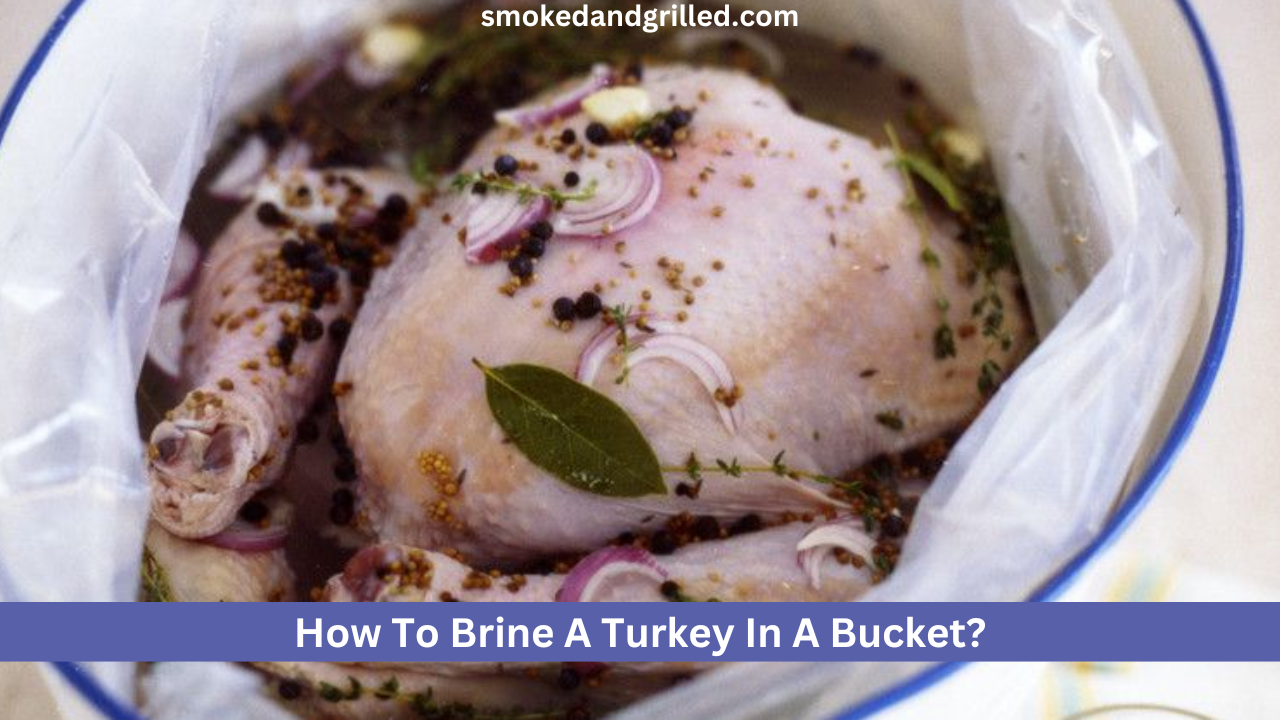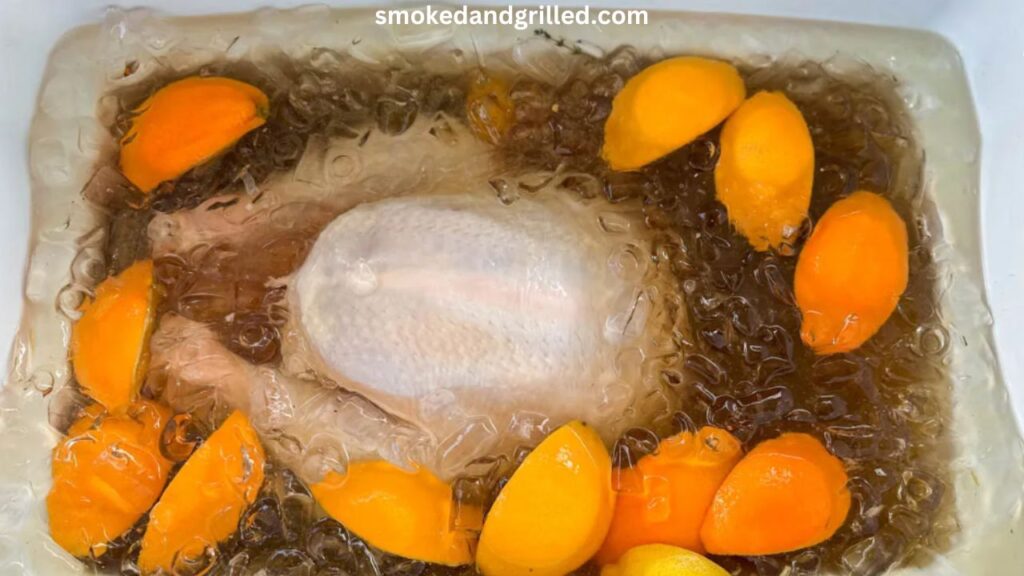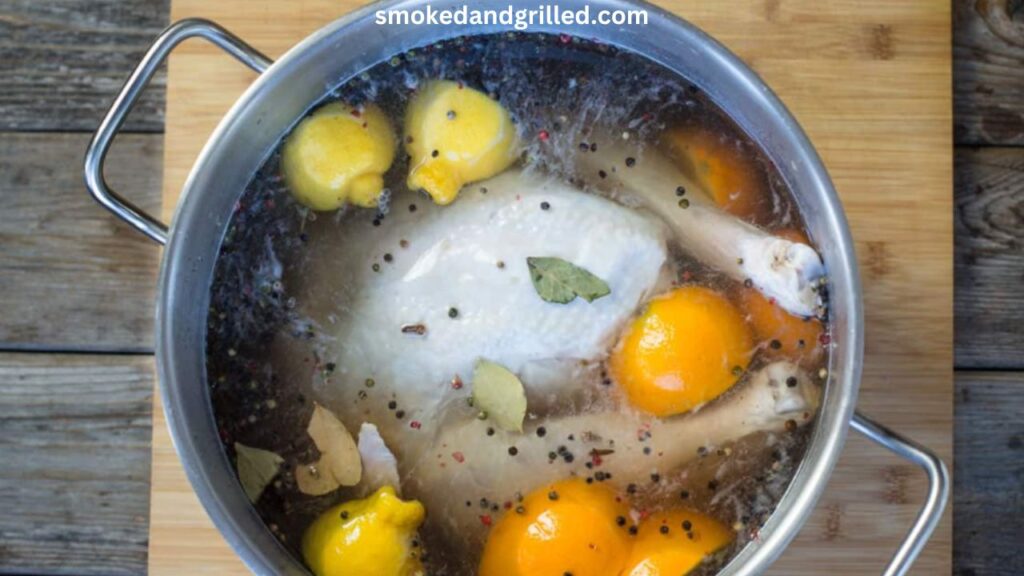Want to make your Thanksgiving meal even better? It’s time to learn how to make delicious, supple meat that will have your visitors pleading for seconds if you’re sick of dry, flavorless turkey.
A tried-and-true technique that consistently produces moist and tasty results is brining a turkey in a bucket.
The brining of the bird not only improves its flavor and texture but also helps to preserve its juiciness, making it a show-stopping centerpiece for your holiday table.
We’ll walk you through the simple process of How To Brine A Turkey In A Bucket? Choosing a food-grade bucket that will fit in your refrigerator is the first step in brining a turkey in a bucket.
In order to be sure that your gourmet creation will be the talk of the town, carefully clean and sterilize the bucket.
Related Posts:
- Can You Brine A Turkey For 48 Hours : The Ultimate Brining Guide
- How Long Is Too Long To Brine A Turkey (The Perfect Duration)
- How Long To Brine A Turkey Breast? (Optimal Time)
How To Brine A Turkey In A Bucket?
Choosing a food-grade bucket that will fit in your refrigerator is the first step in brining a turkey in a bucket.
Put the turkey in the bucket and cover it completely with the cooled brine.
If necessary, add water. After covering the bucket with a lid, chill it for 12 to 24 hours while rotating the turkey every so often. The turkey should be rinsed and dried after brining before cooking.
Brining increases taste and juiciness, but following good food safety procedures is essential for a satisfying dinner that is also secure.
How Long Should I Brine A Turkey In A Bucket?
The suggested brining period for a turkey in a bucket is generally 12 to 24 hours.
The precise amount of time depends on the turkey’s size and the cook’s preferences.
A smaller turkey might only need to brine for 12 hours, while a larger one might need closer to 24.
It’s crucial to adhere to the suggested brining time because going overboard can cause a salty or mushy texture.
When the desired brining period has passed, take the turkey out of the brine, give it a good washing, and pat it dry before continuing with the cooking method of your choice.
Can I Use Any Type Of Bucket For Brining A Turkey?
Use a food-grade bucket to brine a turkey in order to assure food safety and prevent any possible contamination.
Food-grade buckets are manufactured from materials that are non-toxic and do not leak harmful compounds into the brine or food.
They are specifically created to be safe for food contact.
Try to find containers that are clearly designated as “food-grade” or created from substances that are safe for consumption, like high-density polyethylene (HDPE) or polypropylene (PP).
These materials are long-lasting, simple to clean, and flavor- or odor-resistant.
Additionally, make sure the bucket will fit in your refrigerator and is big enough to comfortably hold the turkey.
The turkey could not be completely submerged in the brine if the bucket is too small.
Before using, don’t forget to completely clean and sterilize the food-grade bucket to get rid of any potential pollutants.
You may brine your turkey safely and enjoy the tasty, juicy results without worrying about food safety by using a suitable food-grade bucket.
Can I Use A Brining Bag Instead Of A Bucket?
Yes, you can brine a turkey without using a bucket by using a brining bag instead.
Brining bags have a number of benefits over buckets.
They are more manageable, more convenient, and take up less room in the refrigerator.
Brining bags are made specifically for brining and are composed of materials that are suitable for consumption.
They won’t cause any harm to the turkey or brine.
To use a brining bag, put it inside a durable pan or dish that can retain the brine and handle the weight of the bird.
Make sure the bag won’t leak and won’t unintentionally open when brining. You can double-bag if you want more security.
It’s a good idea to turn or massage the bag occasionally to distribute the brine evenly and make sure the entire turkey is brining.
The amount of time needed to brine a turkey remains the same as when using a bucket, approximately 12 to 24 hours.
When the turkey has finished brining, take it out of the bag, thoroughly rinse it under cold water to get rid of the extra salt, and then pat it dry before cooking.
A brining bag is a practical and efficient way to brine a turkey, producing moist, tasty flesh.
What Ingredients Do I Need For A Turkey Brine?
To create a flavorful turkey brine, you will need a combination of ingredients. Here are the essential components for a basic turkey brine:
- Water: Enough to cover the turkey completely in the water.
- Salt: Most of the time, Kosher salt or sea salt is used to brine. The salt softens the meat and makes it taste better.
- Sugar: Granulated sugar or brown sugar gives a touch of sweetness to balance out the savory flavors.
- Herbs and Spices: This depends on the person, but herbs and spices like bay leaves, peppers, thyme, rosemary, sage, and garlic are often used. These items add smelly flavors to the turkey.
- Optional: You can change the sauce even more by adding things like citrus zest, onion, cinnamon sticks, or other spices, depending on how you like your food to taste.
Make sure to change the amounts of the ingredients based on how big your turkey is and how much taste you want. It’s always a good idea to follow a recipe or set of rules to make sure that your turkey brine has the right proportions and mix of flavors.
How Do I Ensure That The Turkey Is Fully Submerged In The Brine?
Ensuring that the turkey is fully submerged in the brine is crucial for effective brining. Here are some tips to achieve this:
1- Use An Appropriately Sized Container:
Choose a bucket, brining bag, or other container that is big enough for the turkey and the brine to cover it fully.
2- Adjust The Amount Of Brine:
Make sure you have enough salt solution to cover the turkey completely.
3- Use A Weight:
Put a clean, food-safe weight on top of the turkey, like a plate or something heavy, to keep it under the brine.
This makes sure that no part of the turkey floats above the brine.
4- Rotate Or Flip The Turkey:
During the brining process, flip or move the turkey every so often to make sure that all sides get the same amount of brine solution.
This helps the brining and taste to stay the same all over the bird.
By doing these things, you can make sure that the turkey stays fully submerged in the brine, which gives it the best chance to soak up the taste and brine.
Does Brining A Turkey Affect The Cooking Method (Roasting, Grilling, Etc.)?
Brining a turkey can change how it is cooked, especially if it is going to be roasted or grilled.
The process of brining helps to add moisture and taste to the turkey, which makes the final product more juicy and flavorful.
So, it’s important to keep an eye on the turkey’s internal temperature and change the cooking time as needed.
Also, the flavors that get into the meat during brining can be used with different cooking ways.
For example, when cooked at a higher temperature, a turkey that has been brined can get a beautiful, crisp skin. In the same way, grilling a turkey that has been brined can give it a smoky, delicious skin.
When cooking a brined turkey, it’s important to follow the right cooking instructions and recipes for the way you choose to get the best results and a tasty final dish.
What Are Some Common Mistakes To Avoid When Brining A Turkey?
It’s important to be aware of common mistakes when brining a turkey to make sure the process goes well. Here are some important ones to stay away from:
1- Insufficient Brine Time:
If you don’t give the turkey enough time to brine, it might not soak up as much taste.
Follow the instructions for the size of your turkey to get the results you want.
2- Over-Brining:
On the other hand, too much soaking can make the turkey too salty or too soft.
Follow the suggested brining time and salt-to-water ratios to avoid brining too long or too much.
3- Not Using A Food-Grade Container:
Putting brine in a container that isn’t made for food can be dangerous because chemicals from the container could get into the brine.
Always use a bucket made for food, a cooling bag, or another safe container for food.
4- Not Fully Submerging The Turkey:
Make sure the turkey is fully submerged in the brine so that the taste gets spread out evenly.
As needed, use weights or add more brine.
5- Not Rinsing The Turkey:
If you don’t rinse the turkey well after brining it, the final product might be too salty.
Rinse the turkey under cold water to get rid of any salt that is on the skin.
By not doing these common things, you can improve the taste and moisture of your brined turkey and make it taste even better.
Are There Any Safety Precautions I Should Take When Brining A Turkey?
Yes, there are important safety precautions to follow when brining a turkey:
1- Use Food-Grade Containers:
Make sure that the bucket, brining bag, or other container you use was made for food and is made of materials that are safe for food to avoid getting it dirty.
2- Maintain Proper Refrigeration:
Don’t brine the turkey at room temperature. Instead, do it in the fridge.
Keeping the turkey and brine cold stops germs from growing and makes sure the food is safe.
3- Practice Good Hygiene:
4- Avoid Cross-Contamination:
Don’t let the juices from a raw turkey touch other things or surfaces. Use different cutting boards, knives, and containers for the raw turkey and the other items.
5- Rinse The Turkey Properly:
Rinse the turkey under cold running water after brining to get rid of any extra salt or broth.
By taking these safety steps, you can reduce the chance of getting sick from food and make sure you have a safe and fun time cooking.
FAQs
Can I Add Sugar Or Honey To The Brine For A Sweeter Flavor?
Absolutely! Adding sugar or honey to the brine can give your turkey a wonderful sweet taste.
These natural sweeteners help keep the flavors in balance and make the meat taste better overall.
Adding brown sugar or honey to the brine can take your turkey to the next level of taste.
Just make sure to change the amounts to suit your taste and the level of sweetness you want.
Before adding it to the turkey, make sure the sugar or honey is fully dissolved in the brine solution.
The result will be a turkey that tastes great and is so juicy that your guests will want more.
Is It Necessary To Use A Whole Turkey For Brining, Or Can I Use Pieces?
You can brine both whole birds and pieces of turkey.
The process is the same whether you pickle a whole turkey or pieces like the breast or legs.
But remember that individual turkey pieces will take less time to brine than a whole turkey.
Depending on how big the pieces are, brining can take anywhere from a few hours to a whole night.
Just make sure that the turkey pieces are completely submerged in the brine and change the brining time as needed.
Pieces of meat that have been brined can be juicy and flavorful, making them a great choice for people who like smaller amounts or shorter cooking times.
Can I Adjust The Brine Recipe For A Smaller Or Larger Turkey?
Absolutely! The brine recipe can be changed to fit the size of your turkey.
If your turkey is smaller, you might need to cut back on the amount of salt, sugar, and other items in the brine.
On the other hand, if your turkey is bigger, you may need to increase the amounts to make sure the taste gets in. It’s important to make sure that the tastes and saltiness are in the right proportions.
You can use a pickle recipe as a guide and change it to suit your tastes and the size of the turkey you are brining.
Just make sure to taste the water before you add the turkey to make sure it tastes good.
Can I Brine A Turkey If I Have A Brine Allergy?
If you are allergic to salt, it is best not to brine the turkey.
The turkey is soaked in a saltwater solution during brining. If you are allergic to brine ingredients like salt, sugar, or other additives, it’s best to look for other ways to cook the turkey.
Instead, think about simmering the turkey with ingredients that don’t cause allergies or using dry rubs to make it taste better.
You can still make a tasty turkey by playing with different seasoning blends and cooking methods that fit your tastes and dietary needs.
Put your health first and look for other ways to make sure you can eat safely and enjoyably.
Conclusion:
Brining a turkey in a bucket is a game-changer in the world of cooking techniques and ways to add taste.
It’s an easy way to turn a regular turkey into a delicious beauty that will make your taste buds dance for joy.
So, grab that bucket, gather your favorite herbs and spices, and put your turkey in a brine solution that will make every bite soft and flavorful in a way that nothing else can.
With this technique in your kitchen, you’ll be the star of Thanksgiving dinner and make stories that people will remember for years. Prepare to pickle and watch the magic happen.
Also Read:



